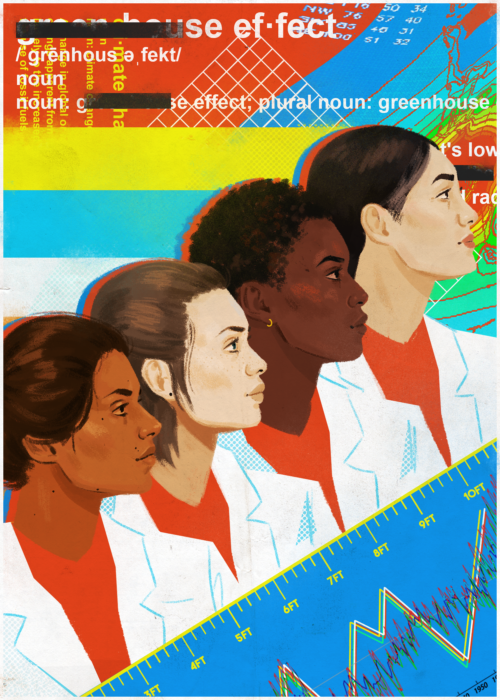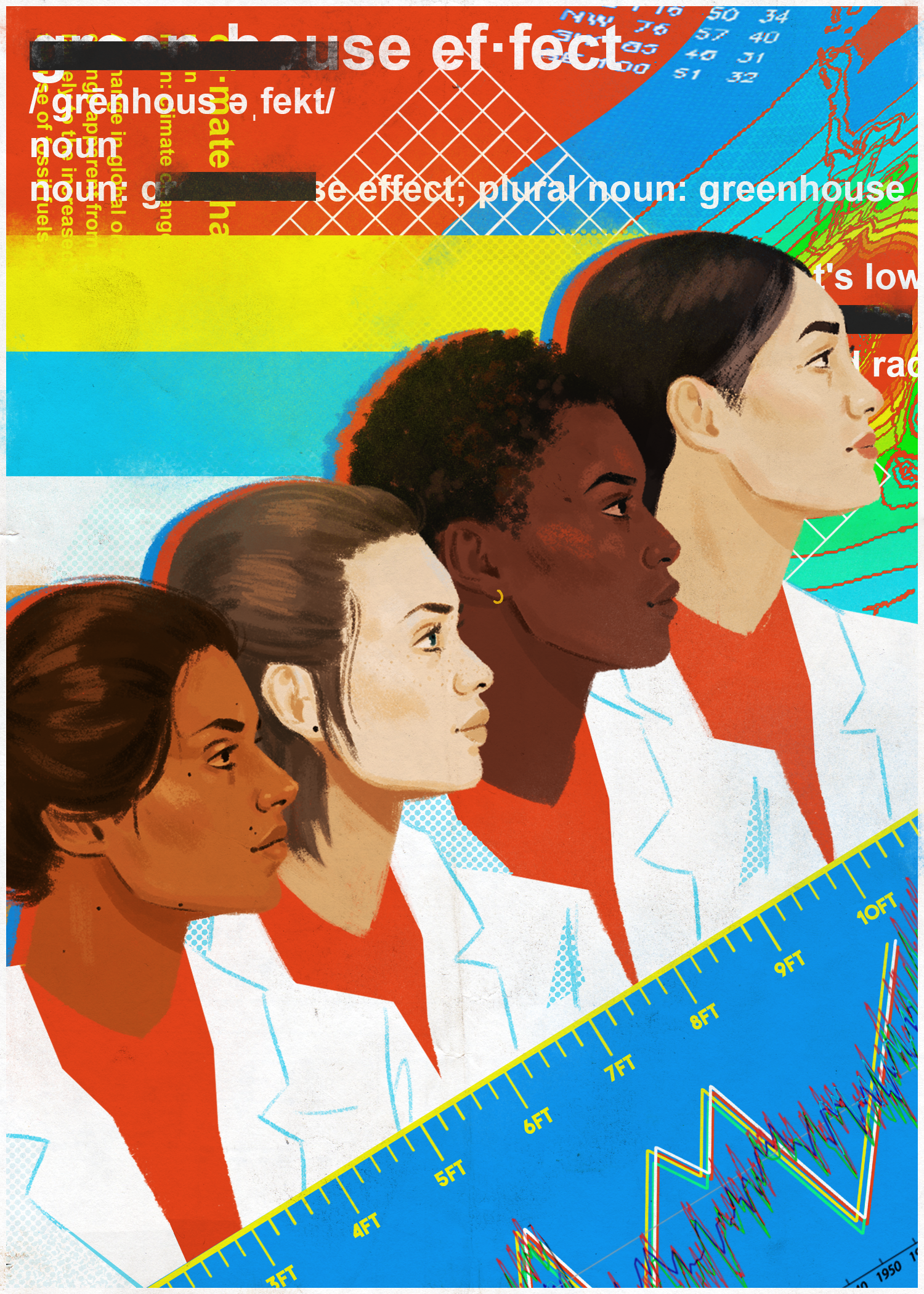
On September 23, a crowd will descend on the University of Colorado Boulder’s Bartlett Center, a place specifically created to link up researchers with the people experiencing climate change — you know, you, me, anyone who attends this event — to spin true yarns about how global warming has changed the tapestry of their lives. The event is tied to the global climate strikes that begin today. Over the next week, millions will march for climate action (or, perhaps, against inaction) and attend accompanying seminars. The Boulder event is one of many done in partnership with an organization called 500 Women Scientists, a group that traces its origins back to this very campus and that most fateful of fall evenings three years ago.
Jane Zelikova was typing into a group text as the votes poured in the night of the 2016 election. State by state, the surprise of Donald Trump’s impending victory coalesced. Zelikova and her group of women scientist friends tried, across the cellular divide, to make sense of this so-split world that didn’t seem to value them very much. They felt uncomfortable heat from the anti-science climate and the hate against minorities, immigrants, members of the LGBTQ community, and people with disabilities. “We were doing a lot of venting,” Zelikova remembered.
The friends had spent years together pursuing doctorates at CU before they dispersed, pollinating the globe. On election night, anger in the group text prevailed for a while, but the women wanted to do more than buzz in their own hive. They moved to email, and started adding other scientists they knew — many, like Zelikova, from Colorado and the West — to the discussion. The thread grew from five people to 20 to 200. The organization that emerged, 500 Women Scientists, gives voice and community to people who might not otherwise have either. It is raising up the next generation of scientific leadership (one more diverse than the last), and uses science to unite people across ideological and geographical divides. And it all started with messages between a few friends.
“We kind of realized there was a need to have a group,” Zelikova said, “to be able to express the feelings and concerns, and to be able to be vulnerable.”
One member of the group, Kelly Ramirez, later described the discussion for Scientific American. “Sexism, inequality, discrimination and anti-intellectualism threaten the progress being made in our society,” Ramirez wrote. “Science, once a pillar of democracy and progress, is under attack. We fear that the scientific progress and momentum in tackling our biggest challenges, including staving off the worst impacts of climate change, will come to an abrupt stop.”
Zelikova and Ramirez took the conversation public in the hope that they could counter the forces that seemed to be countering them. They composed an open letter that other women scientists could sign; in doing so, they committed to help their community value science and all of humanity. “In this new era of anti-science and misinformation, we as women scientists re-affirm our commitment to build a more inclusive society and scientific enterprise,” they wrote.
The group of 200 thought they could get 300 more signatories, thus the name: 500 Women Scientists. “That was the goal,” said Zelikova, who studies how climate change affects Western ecosystems at the University of Wyoming. “That seemed ambitious at the time.”
The group published their note, wrote about it in the Scientific American piece, and launched a website where other women could pledge support and find each other. “I remember sitting there just watching the signatures roll in,” Zelikova said. “The people who were signing were my science heroes.” They, it turned out, wanted science — and the planet that science helps shape — to be the same equitable, just place that she desired. This effort, Zelikova thought, could be bigger than 500 people. Bigger than a pledge, than a website.
The whole thing might have seemed anathema to some scientists. After all, researchers are often told that their job is not to agitate the political or social oceans; rather, they’re told to be objective, steer clear of soft stuff, and keep quiet except about hard data. But that’s a skewed view of science, which swims in the same cultural medium as the rest of society.
Science, after all, is a human enterprise. Data, those impartial figures underpinning science, are both collected and interpreted by people with different backgrounds and motivations. For instance, a 2017 Nature Communications study showed that brain-imaging scientists tend to examine what social researchers call WEIRD (White, Educated, Industrial, Rich, Developed) groups, and that has skewed the view of how brains develop and age. We imagine that science lives or dies or disseminates on merit alone, but in 2018, University of Colorado Boulder researchers found that “research from prestigious institutions spreads more quickly and completely than work of similar quality originating from less prestigious institutions.”
Science gets knocked around by political winds, too, as Trump’s recent permanent-marker alteration of Hurricane Dorian’s path illustrates. As neuroscientist Ubadah Sabbagh put it in Scientific American, “Society forms politics, politics controls science, and science informs both society and politics.”
Zelikova’s crew wanted to acknowledge that. As a start, the group organized a meetup at the December 2016 American Geophysical Union meeting in San Francisco, a gathering of tens of thousands of scientists. At the meeting, they set the tone they wanted to use going forward by attending a protest in front of the city’s Moscone Center. “We went strong on advocacy,” Zelikova said, in panel discussions as well as at the protest, “with a feminist voice.” They were embracing, rather than shrugging off, the politics inherent to science.
500 Women Scientists quickly attracted far more than 500 women scientists — more than 20,000 supporters have signed the pledge so far. Zelikova and the team built a database of woman-identified researchers so journalists looking for sources, scientific journals seeking peer-reviewers, and conference organizers booking speakers could see beyond the glare of the usual suspects (the common refrain: male, pale, and stale) who give all the quotes and get all the keynotes. The database’s ensuing popularity has actually become a problem. “Because we built it with Scotch tape and sticks, it can’t handle how much it’s accessed,” Zelikova said. With support from the Simons Foundation and Lyda Hill Philanthropies, they’re revamping it and launching a similar search spot for women in the medical field.
The thousands-strong group doesn’t live solely online. More than 300 local groups, called pods, have sprouted. The pods help the larger organization carry out programs like its 2017 “Summer of Op-eds,” in which members opined about the federal science budget in a series of letters; they’re ramping up a similar program to accompany the upcoming climate strikes. The pods will link up with the youth-led strikes, host teach-ins, and put together climate-oriented storytelling events like the one in Boulder.
Other actions target diversity. The group’s Fellowship for the Future is designed to help women of color, and 500 Women Scientists assembled a more racially diverse leadership than the initial Colorado cohort represented. Its #SciMomJourneys project helps mothers find resources. Wikithons are held to create more Wikipedia entries for women scientists, and a new project with nonprofit SisterSong aims to bring reproductive justice into the arsenal.
500 Women Scientists’ initiatives aim to improve science by improving the scientific culture for women and minorities. After all, science, like social change, requires that people have the audacity to think the world could be different, and the gumption to make it so.
Editor’s note: This post has been updated to note that 500 Women Scientists members attended the protest at AGU; the group did not organize it.

